traction control LINCOLN MKS 2016 Owners Manual
[x] Cancel search | Manufacturer: LINCOLN, Model Year: 2016, Model line: MKS, Model: LINCOLN MKS 2016Pages: 382, PDF Size: 3.81 MB
Page 6 of 382
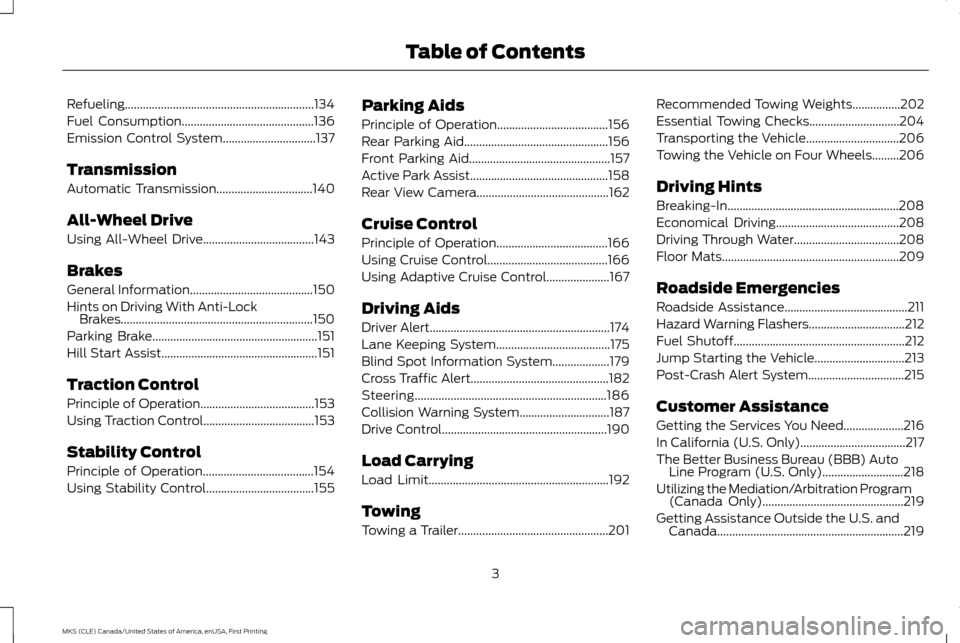
Refueling...............................................................134
Fuel Consumption............................................136
Emission Control System...............................137
Transmission
Automatic Transmission
................................140
All-Wheel Drive
Using All-Wheel Drive.....................................143
Brakes
General Information
.........................................150
Hints on Driving With Anti-Lock Brakes................................................................150
Parking Brake
.......................................................151
Hill Start Assist
....................................................151
Traction Control
Principle of Operation......................................153
Using Traction Control
.....................................153
Stability Control
Principle of Operation.....................................154
Using Stability Control....................................155 Parking Aids
Principle of Operation.....................................156
Rear Parking Aid................................................156
Front Parking Aid
...............................................157
Active Park Assist..............................................158
Rear View Camera
............................................162
Cruise Control
Principle of Operation
.....................................166
Using Cruise Control........................................166
Using Adaptive Cruise Control.....................167
Driving Aids
Driver Alert
............................................................174
Lane Keeping System......................................175
Blind Spot Information System
...................179
Cross Traffic Alert..............................................182
Steering................................................................186
Collision Warning System..............................187
Drive Control
.......................................................190
Load Carrying
Load Limit............................................................192
Towing
Towing a Trailer
..................................................201 Recommended Towing Weights................202
Essential Towing Checks..............................204
Transporting the Vehicle...............................206
Towing the Vehicle on Four Wheels.........206
Driving Hints
Breaking-In.........................................................208
Economical Driving
.........................................208
Driving Through Water...................................208
Floor Mats
...........................................................209
Roadside Emergencies
Roadside Assistance
.........................................211
Hazard Warning Flashers................................212
Fuel Shutoff
.........................................................212
Jump Starting the Vehicle..............................213
Post-Crash Alert System................................215
Customer Assistance
Getting the Services You Need....................216
In California (U.S. Only)...................................217
The Better Business Bureau (BBB) Auto Line Program (U.S. Only)...........................218
Utilizing the Mediation/Arbitration Program (Canada Only)
...............................................219
Getting Assistance Outside the U.S. and Canada..............................................................219
3
MKS (CLE) Canada/United States of America, enUSA, First Printing Table of Contents
Page 54 of 382

•
Various vehicle speed minders can be set.
Once you select a speed, it will be shown
in the display, followed by an audible tone
when the preselected vehicle speed is
exceeded.
• Audio system maximum volume of 45%.
A message will be shown in the display
when you attempt to exceed the limited
volume. Also, the speed-sensitive or
compensated automatic volume control
will be disabled. •
Always on setting. When this is selected,
you will not be able to turn off
AdvanceTrac or traction control, E911 or
Emergency Assist, or the Do Not Disturb
feature (if your vehicle is equipped with
these features).
CREATING A MYKEY
Use the information display to create a
MyKey: 1. Insert the key you want to program into
the ignition. If your vehicle is equipped
with a push-button start, place the
remote control into the backup position.
The location of your backup position is in
another chapter. See Starting a
Gasoline Engine (page 128).
2. Switch the ignition on.
3. Access the main menu on the information
display controls. Use the arrow keys to
get to the following menu selections: Action and Description
Message
Press the
OK button or the right arrow key.
Settings
Press the
OK button or the right arrow key.
MyKey
Press the
OK button or the right arrow key.
Create MyKey
When prompted, hold the
OK button until
you see a message informing you to label this
key as a MyKey. The key will be restricted at
the next start.
MyKey is successfully created. Make sure you
label it so you can distinguish it from the
admin keys. You can also program configurable settings
for the key(s). See
Programming/Changing Configurable
Settings
.
Programming/Changing
Configurable Settings
Use the information display to access your
configurable MyKey settings. 1.
Switch the ignition on using an admin key
or remote control.
2. Access the main menu on the information
display controls. Use the arrow keys to
get to the following menu selections:
51
MKS (CLE) Canada/United States of America, enUSA, First Printing MyKey
™
Page 95 of 382

Driver Assist
Use the up or down arrow buttons to choose
between the following display options.Note:
Some items are optional and may not
appear. Driver Assist
Traction Control
Blindspot High, Normal or Low
Sensitivity
Collision Warn
Cross Traffic
—
Adaptive or Normal
Cruise Control
Driver Alert
Front Park Aid
Alert, Aid or Both
Mode
Lane Keeping
High, Normal or Low
Intensity
Rear Park Aid
Settings
In this mode, you can configure different
driver setting choices. Note:
Some items are optional and may not
appear.
92
MKS (CLE) Canada/United States of America, enUSA, First Printing Information Displays
Page 97 of 382
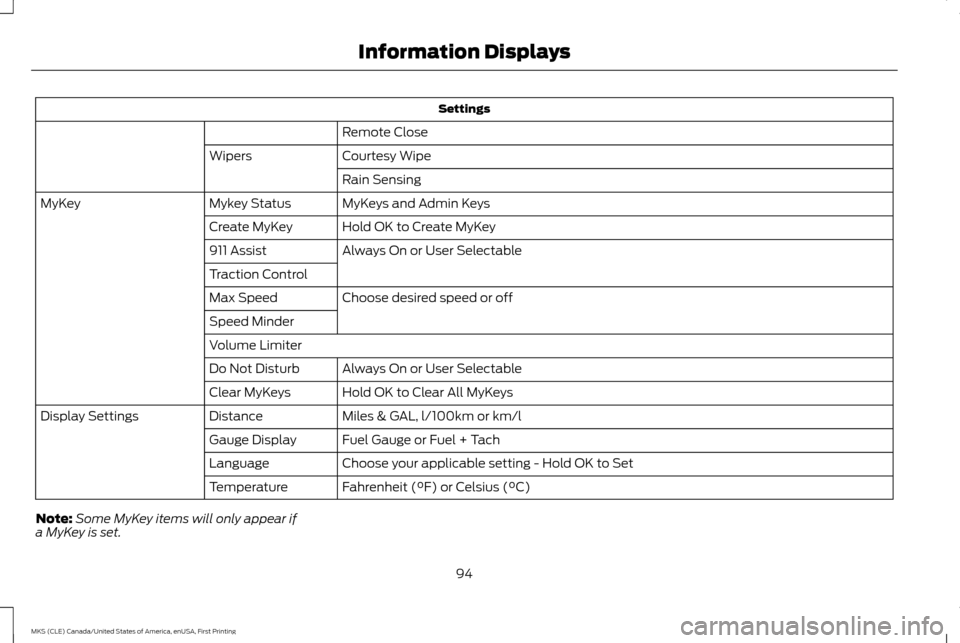
Settings
Remote Close
Courtesy Wipe
Wipers
Rain Sensing
MyKeys and Admin Keys
Mykey Status
MyKey
Hold OK to Create MyKey
Create MyKey
Always On or User Selectable
911 Assist
Traction Control
Choose desired speed or off
Max Speed
Speed Minder
Volume Limiter
Always On or User Selectable
Do Not Disturb
Hold OK to Clear All MyKeys
Clear MyKeys
Miles & GAL, l/100km or km/l
Distance
Display Settings
Fuel Gauge or Fuel + Tach
Gauge Display
Choose your applicable setting - Hold OK to Set
Language
Fahrenheit (°F) or Celsius (°C)
Temperature
Note: Some MyKey items will only appear if
a MyKey is set.
94
MKS (CLE) Canada/United States of America, enUSA, First Printing Information Displays
Page 98 of 382
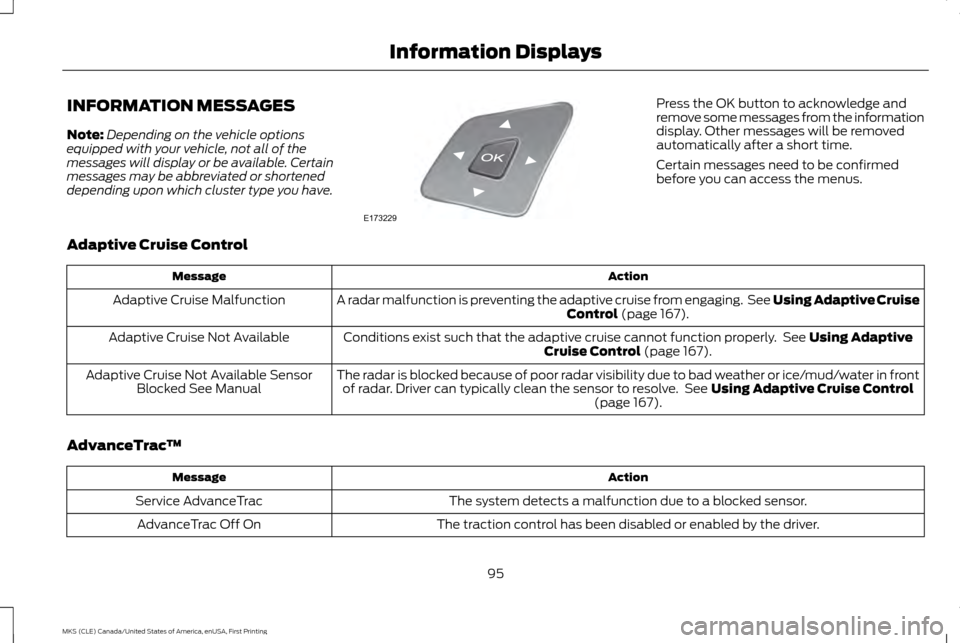
INFORMATION MESSAGES
Note:
Depending on the vehicle options
equipped with your vehicle, not all of the
messages will display or be available. Certain
messages may be abbreviated or shortened
depending upon which cluster type you have. Press the OK button to acknowledge and
remove some messages from the information
display. Other messages will be removed
automatically after a short time.
Certain messages need to be confirmed
before you can access the menus.
Adaptive Cruise Control Action
Message
A radar malfunction is preventing the adaptive cruise from engaging. See Using Adaptive Cruise Control (page 167).
Adaptive Cruise Malfunction
Conditions exist such that the adaptive cruise cannot function properly. See
Using Adaptive
Cruise Control (page 167).
Adaptive Cruise Not Available
The radar is blocked because of poor radar visibility due to bad weather or ice/mud/water in frontof radar. Driver can typically clean the sensor to resolve. See
Using Adaptive Cruise Control
(page 167).
Adaptive Cruise Not Available Sensor
Blocked See Manual
AdvanceTrac ™ Action
Message
The system detects a malfunction due to a blocked sensor.
Service AdvanceTrac
The traction control has been disabled or enabled by the driver.
AdvanceTrac Off On
95
MKS (CLE) Canada/United States of America, enUSA, First Printing Information DisplaysE173229
Page 150 of 382
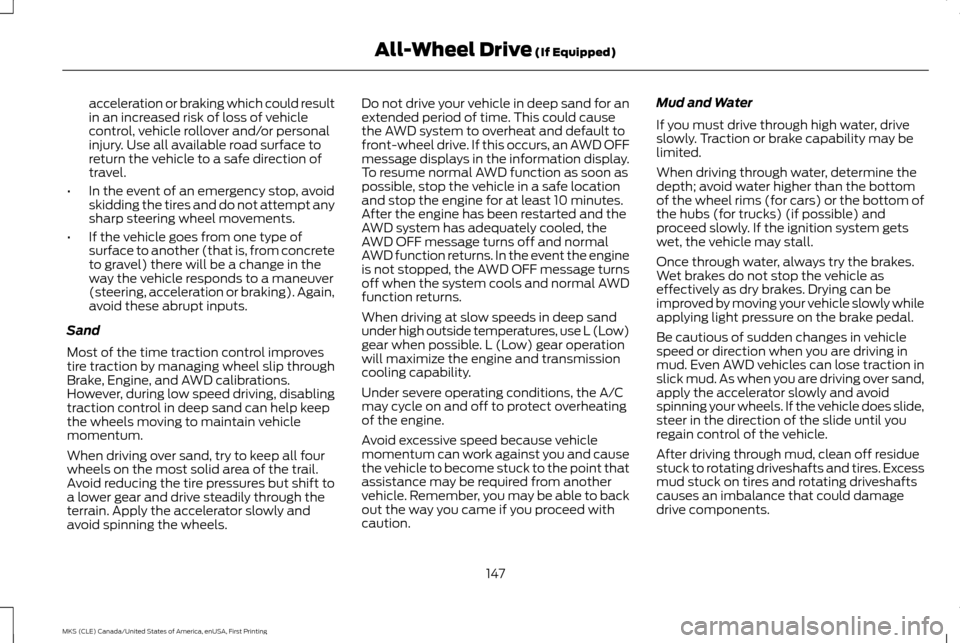
acceleration or braking which could result
in an increased risk of loss of vehicle
control, vehicle rollover and/or personal
injury. Use all available road surface to
return the vehicle to a safe direction of
travel.
• In the event of an emergency stop, avoid
skidding the tires and do not attempt any
sharp steering wheel movements.
• If the vehicle goes from one type of
surface to another (that is, from concrete
to gravel) there will be a change in the
way the vehicle responds to a maneuver
(steering, acceleration or braking). Again,
avoid these abrupt inputs.
Sand
Most of the time traction control improves
tire traction by managing wheel slip through
Brake, Engine, and AWD calibrations.
However, during low speed driving, disabling
traction control in deep sand can help keep
the wheels moving to maintain vehicle
momentum.
When driving over sand, try to keep all four
wheels on the most solid area of the trail.
Avoid reducing the tire pressures but shift to
a lower gear and drive steadily through the
terrain. Apply the accelerator slowly and
avoid spinning the wheels. Do not drive your vehicle in deep sand for an
extended period of time. This could cause
the AWD system to overheat and default to
front-wheel drive. If this occurs, an AWD OFF
message displays in the information display.
To resume normal AWD function as soon as
possible, stop the vehicle in a safe location
and stop the engine for at least 10 minutes.
After the engine has been restarted and the
AWD system has adequately cooled, the
AWD OFF message turns off and normal
AWD function returns. In the event the engine
is not stopped, the AWD OFF message turns
off when the system cools and normal AWD
function returns.
When driving at slow speeds in deep sand
under high outside temperatures, use L (Low)
gear when possible. L (Low) gear operation
will maximize the engine and transmission
cooling capability.
Under severe operating conditions, the A/C
may cycle on and off to protect overheating
of the engine.
Avoid excessive speed because vehicle
momentum can work against you and cause
the vehicle to become stuck to the point that
assistance may be required from another
vehicle. Remember, you may be able to back
out the way you came if you proceed with
caution. Mud and Water
If you must drive through high water, drive
slowly. Traction or brake capability may be
limited.
When driving through water, determine the
depth; avoid water higher than the bottom
of the wheel rims (for cars) or the bottom of
the hubs (for trucks) (if possible) and
proceed slowly. If the ignition system gets
wet, the vehicle may stall.
Once through water, always try the brakes.
Wet brakes do not stop the vehicle as
effectively as dry brakes. Drying can be
improved by moving your vehicle slowly while
applying light pressure on the brake pedal.
Be cautious of sudden changes in vehicle
speed or direction when you are driving in
mud. Even AWD vehicles can lose traction in
slick mud. As when you are driving over sand,
apply the accelerator slowly and avoid
spinning your wheels. If the vehicle does slide,
steer in the direction of the slide until you
regain control of the vehicle.
After driving through mud, clean off residue
stuck to rotating driveshafts and tires. Excess
mud stuck on tires and rotating driveshafts
causes an imbalance that could damage
drive components.
147
MKS (CLE) Canada/United States of America, enUSA, First Printing All-Wheel Drive
(If Equipped)
Page 151 of 382

Note:
Driving through deep water may
damage the transmission.
If the front or rear axle is submerged in water,
have the power transfer unit (PTU) or rear
axle serviced by an authorized dealer. “Tread Lightly
” is an educational program
designed to increase public awareness of
land-use regulations and responsibilities in
our nations wilderness areas. Ford Motor
Company joins the U.S. Forest Service and
the Bureau of Land Management in
encouraging you to help preserve our national
forest and other public and private lands by
“treading lightly. ” Driving on Hilly or Sloping Terrain
Note:
Avoid driving crosswise or turning on
steep slopes or hills. A danger lies in losing
traction, slipping sideways and possibly rolling
over. Whenever driving on a hill, determine
beforehand the route you will use. Do not drive
over the crest of a hill without seeing what
conditions are on the other side. Do not drive
in reverse over a hill without the aid of an
observer.
Although natural obstacles may make it
necessary to travel diagonally up or down a
hill or steep incline, you should always try to
drive straight up or straight down.
When climbing a steep slope or hill, start in
a lower gear rather than downshifting to a
lower gear from a higher gear once the ascent
has started. This reduces strain on the engine
and the possibility of stalling.
If you do stall out, do not try to turnaround
because you might roll over. It is better to
back down to a safe location.
Apply just enough power to the wheels to
climb the hill. Too much power will cause the
tires to slip, spin or lose traction, resulting in
loss of vehicle control. Descend a hill in the same gear you would
use to climb up the hill to avoid excessive
brake application and brake overheating. Do
not descend in neutral; instead, disengage
overdrive or manually shift to a lower gear.
When descending a steep hill, avoid sudden
hard braking as you could lose control. The
front wheels have to be turning in order to
steer the vehicle.
Your vehicle has anti-lock brakes, therefore
apply the brakes steadily. Do not
“pump” the
brakes.
148
MKS (CLE) Canada/United States of America, enUSA, First Printing All-Wheel Drive (If Equipped)E143950 E143949
Page 156 of 382

PRINCIPLE OF OPERATION
The traction control system helps avoid drive
wheel spin and loss of traction.
If your vehicle begins to slide, the system
applies the brakes to individual wheels and,
when needed, reduces engine power at the
same time. If the wheels spin when
accelerating on slippery or loose surfaces,
the system reduces engine power in order to
increase traction.
USING TRACTION CONTROL
WARNING
The stability and traction control light
illuminates steadily if the system
detects a failure. Make sure you did not
manually disable the traction control system
using the information display controls or the
switch. If the stability control and traction
control light is still illuminating steadily, have
the system serviced by an authorized dealer
immediately. Operating your vehicle with the
traction control disabled could lead to an
increased risk of loss of vehicle control,
vehicle rollover, personal injury and death. The system automatically turns on each time
you switch the ignition on.
If your vehicle is stuck in mud or snow,
switching traction control off may be
beneficial as this allows the wheels to spin.
Note:
When you switch traction control off,
stability control remains fully active.
Switching the System Off
When you switch the system off or on, a
message appears in the information display
showing system status.
You can switch the system off by either using
the information display controls or the switch.
Using the Information Display
Controls
You can switch this feature off or on in the
information display. See Using Traction
Control (page 153).
Using a Switch
(If Equipped)
Use the traction control switch on the
instrument panel to switch the system off or
on.
The switch illuminates when traction control
is off. System Indicator Lights and
Messages The stability and traction control
light:
• Temporarily illuminates on engine
start-up.
• Flashes when a driving condition
activates either of the systems.
• Illuminates if a problem occurs in either
of the systems. The stability and traction control
off light temporarily illuminates on
engine start-up and stays on when
you switch the traction control system off.
153
MKS (CLE) Canada/United States of America, enUSA, First Printing Traction ControlE138639
Page 157 of 382
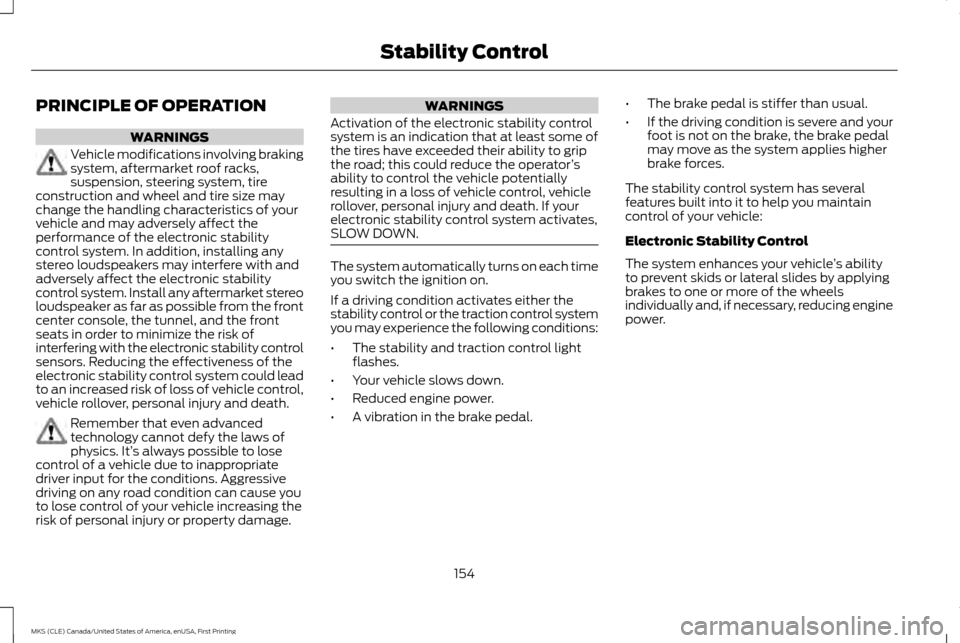
PRINCIPLE OF OPERATION
WARNINGS
Vehicle modifications involving braking
system, aftermarket roof racks,
suspension, steering system, tire
construction and wheel and tire size may
change the handling characteristics of your
vehicle and may adversely affect the
performance of the electronic stability
control system. In addition, installing any
stereo loudspeakers may interfere with and
adversely affect the electronic stability
control system. Install any aftermarket stereo
loudspeaker as far as possible from the front
center console, the tunnel, and the front
seats in order to minimize the risk of
interfering with the electronic stability control
sensors. Reducing the effectiveness of the
electronic stability control system could lead
to an increased risk of loss of vehicle control,
vehicle rollover, personal injury and death. Remember that even advanced
technology cannot defy the laws of
physics. It’
s always possible to lose
control of a vehicle due to inappropriate
driver input for the conditions. Aggressive
driving on any road condition can cause you
to lose control of your vehicle increasing the
risk of personal injury or property damage. WARNINGS
Activation of the electronic stability control
system is an indication that at least some of
the tires have exceeded their ability to grip
the road; this could reduce the operator ’s
ability to control the vehicle potentially
resulting in a loss of vehicle control, vehicle
rollover, personal injury and death. If your
electronic stability control system activates,
SLOW DOWN. The system automatically turns on each time
you switch the ignition on.
If a driving condition activates either the
stability control or the traction control system
you may experience the following conditions:
•
The stability and traction control light
flashes.
• Your vehicle slows down.
• Reduced engine power.
• A vibration in the brake pedal. •
The brake pedal is stiffer than usual.
• If the driving condition is severe and your
foot is not on the brake, the brake pedal
may move as the system applies higher
brake forces.
The stability control system has several
features built into it to help you maintain
control of your vehicle:
Electronic Stability Control
The system enhances your vehicle ’s ability
to prevent skids or lateral slides by applying
brakes to one or more of the wheels
individually and, if necessary, reducing engine
power.
154
MKS (CLE) Canada/United States of America, enUSA, First Printing Stability Control
Page 158 of 382
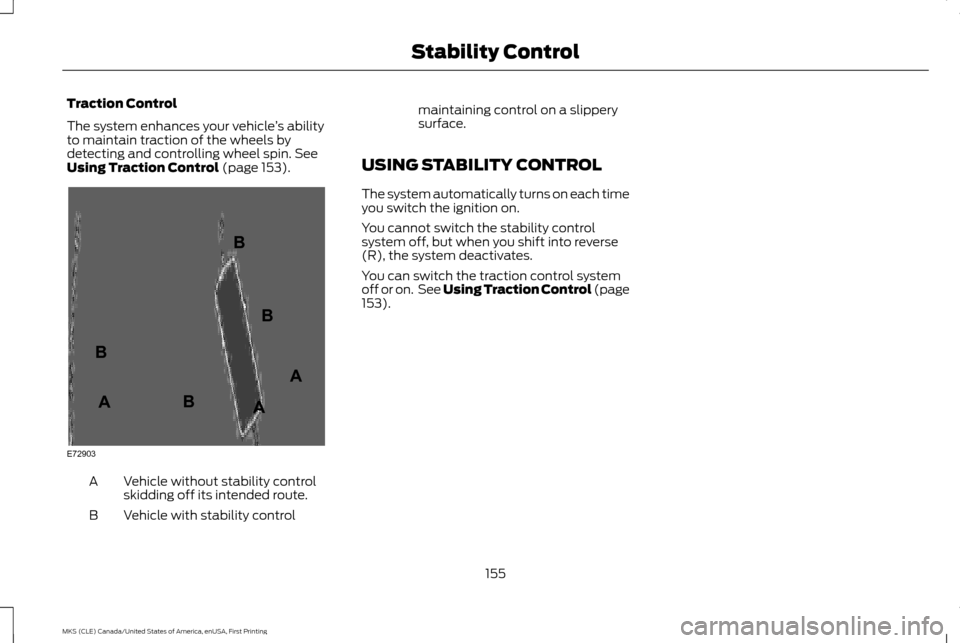
Traction Control
The system enhances your vehicle
’s ability
to maintain traction of the wheels by
detecting and controlling wheel spin. See
Using Traction Control (page 153). Vehicle without stability control
skidding off its intended route.
A
Vehicle with stability control
B maintaining control on a slippery
surface.
USING STABILITY CONTROL
The system automatically turns on each time
you switch the ignition on.
You cannot switch the stability control
system off, but when you shift into reverse
(R), the system deactivates.
You can switch the traction control system
off or on. See Using Traction Control (page
153
).
155
MKS (CLE) Canada/United States of America, enUSA, First Printing Stability ControlE72903A
AA
B
BB
B